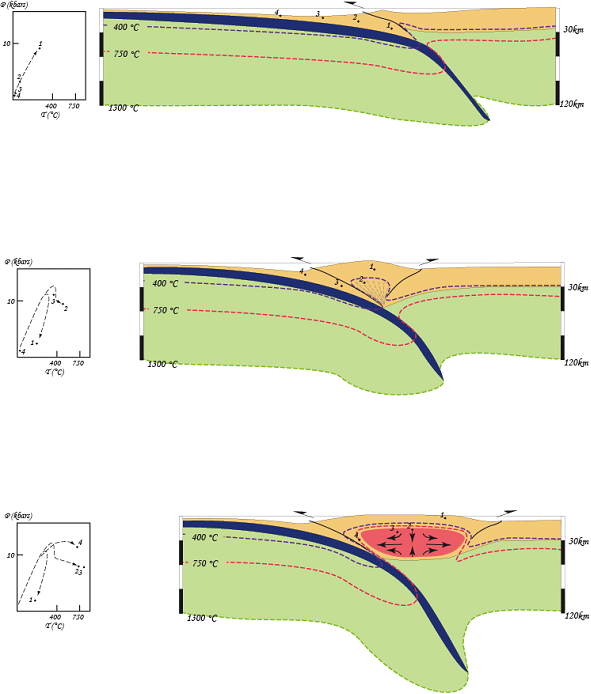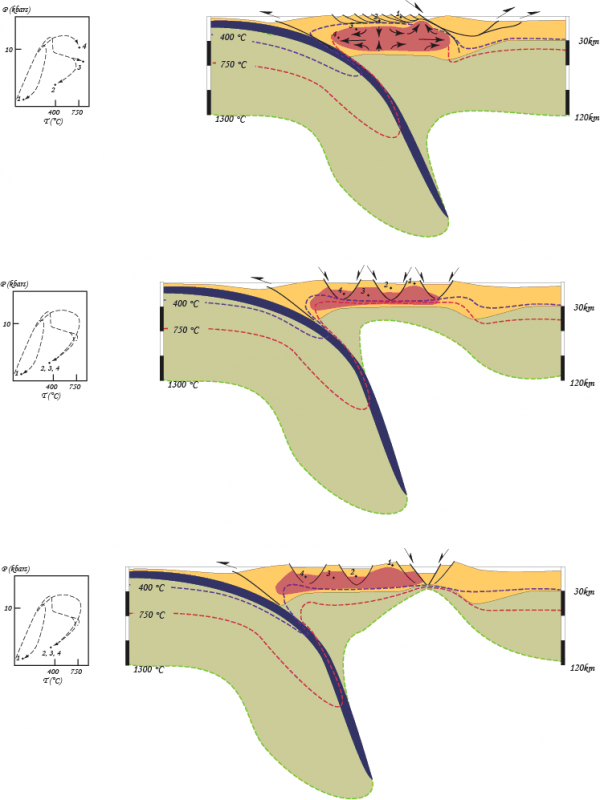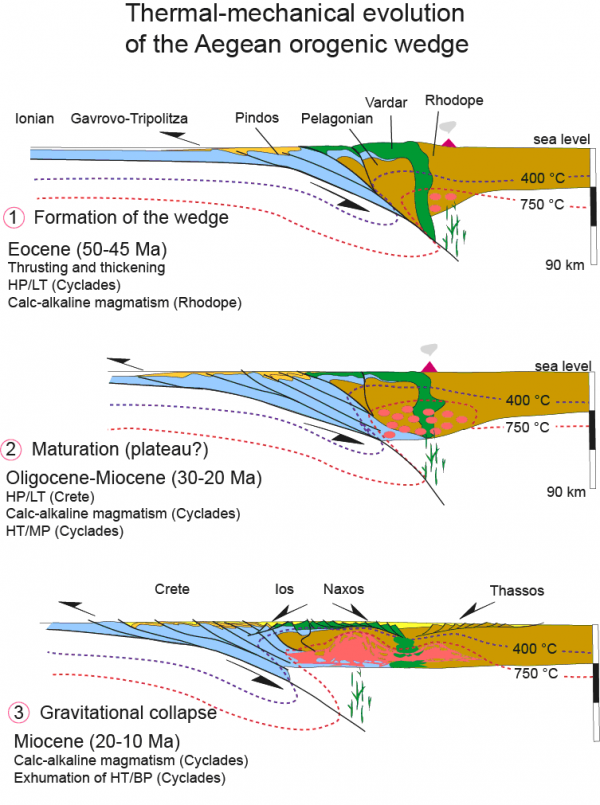We present a tectonic reconstruction of the Aegean domain that addresses the evolution of topography, crustal wedge deformation and thermal evolution and leads to an assessment of the interplay between plate dynamics and surface processes on the evolution of the crust located at the boundary between the converging African and European plates.
The central Aegean domain, as expressed in the island of Naxos, is characterized by the exhumation of metamorphic rocks juxtaposed to Oligocene to Upper Pliocene sedimentary basins along low-angle detachments. The metamorphic rocks comprise a Mesozoic sequence of metasedimentary rocks overlain by a weakly metamorphosed ophiolitic mélange. In contrast, the Mesozoic metasedimentary sequence is affected by a metamorphism grading from blue schist to amphibolite facies with the genesis of migmatites exposed in the core of structural domes. Inherited Mesozoic and Paleozoic cores of zircons from the migmatites are rimmed by metamorphic overgrowths dated respectively at ca. 50 Ma and ca. 15 Ma. Ar-Ar and Rb-Sr ages decrease from ca. 45 Ma in the blue schists to ca. 7 Ma in the migmatites.
These data indicate that the evolution of the central Aegean domain is characterized by (1) Eocene burial and subsequent exhumation of the Mesozoic metasedimentary rocks under a low geothermal gradient; (2) increase in the geothermal gradient and development of migmatitic domes and low-angle detachments in Miocene times coeval with surface subsidence; (3) Mio-Pliocene final exhumation of the metamorphic rocks associated to surface uplift.
This reconstruction suggests a model for the thermal-mechanical evolution of the Aegean crustal wedge that includes, (1) tectonic accretion associated to subduction and extrusion of crustal slices facilitated by slab roll-back, (2) thinning of the crustal wedge coeval with its thermal maturation and (3) final uplift and gravitational collapse in response to asthenospheric upwelling above the retreating slab. Thinning of the previously thickened crustal accretionary wedge occurs in three stages. The first one corresponds to the development of a MCC, as the crust is dominantly ductile. The second stage corresponds to the formation of a wide rift and at last, the third stage is the localization of extension in narrow rifts as the crust cools down during thinning.
The same sequence of events affected the Rodhope massif in northern Greece but earlier in time. Indeed, HP/LT metamorphism was recorded between 75-70 My and HT metamorphism between 40-30 My. HP/LT metamorphism affected metamorphic rocks exhumed in Crete around 25 My. This suggests that subduction and exhumation of HP/LT rocks occurs above the subducting slab at the front of the crustal accretionary wedge. As the deformation front migrates southward with the retreating slab, the early accreted metamorphic rocks become passive in terms of deformation but are affected by thermal relaxation. 20 to 30 My after accretion, thermal relaxation is causing partial melting of the crustal wedge. This weakens the crust and causes localization of crustal thinning in response to slab roll-back. At last, the NE-SW shortening component observed in the Aegean domain might reflect crustal scale redistribution of mass from the Hellenides and the Taurides that are not affected to the same extent by slab roll-back.
Figure 25a. Thermal mechanical model

Thermal mechanical model for the evolution of the Aegean crustal accretionary wedge
Figure 25b. Thermal mechanical model

Thermal mechanical model for the evolution of the Aegean crustal accretionary wedge
Figure 25c. Thermal mechanical model

Thermal mechanical model for the evolution of the Aegean crustal accretionary wedge